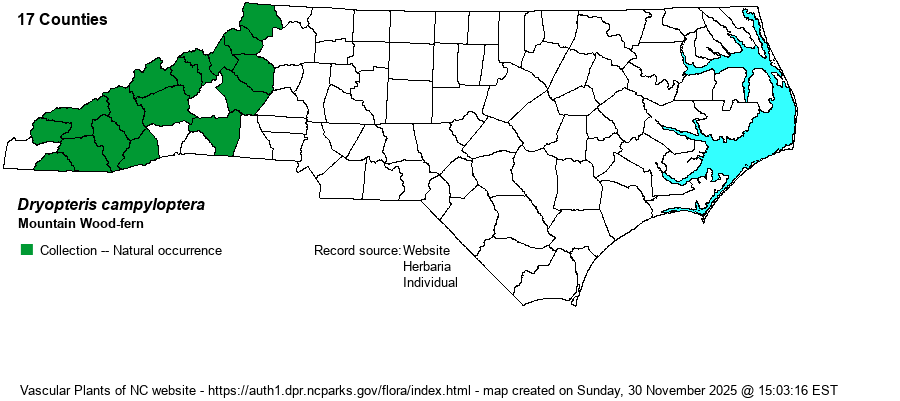| Author | (Kunze) Clarkson | |
| Distribution | Essentially throughout the Mountains; not present downstate. Most specimens at DUKE have been annotated to "D. austriaca", which is interpreted to include taxon campyloptera as a synonym. However, some of the specimens at DUKE may actually refer to D. carthusiana.
This is primarily an Appalachian and Northeastern species, ranging from Newf and Que southward primarily in the Appalachians to western NC and eastern TN. | |
| Abundance | Fairly common to locally common in the Mountains, only at the higher elevations -- mainly above 4500 feet. The website editors suggest that a State Rank of S4 is more suitable for it than S3, as it is readily found at many high elevation sites. | |
| Habitat | This is a high elevation species in NC, found in cool forests, particularly numerous in spruce-fir forests. It also grows in Northern Hardwood Forests and in Boulderfield Forests. |
| Phenology | Fruits from July to September. | |
| Identification | This is a familiar fern if you spend much time in spruce-fir forests, but it is not present lower down in most cove forests. It is a very lacy fern, highly dissected. The are several stipes arising in a clump, often being 6-10 inches long, and quite scaly. The large blade is widely ovate to nearly triangular, about 15-20 inches long and about 12 inches wide. The blades are tripinnate-pinnatifid, meaning that each pinnule is further divided into pinnules and each of these secondary pinnules is also lobed. This species can be easily confused with D. intermedia, which also grows in the mountains, though mainly at lower elevations and has an evergreen frond (though it is not coriaceous or thick). In D. campyloptera, on the lowest pinna the first pinnule on the bottom is longer than the second pinnule on the bottom (and thus the whole pinna has a triangular shape). In D. intermedia, this first bottom pinnule of the lowest pinna is distinctly shorter than the second pinnule, and thus the basal pinna is tapered to the base. Also, the blade of D. intermedia is more parallel-sided (upper pinnae almost as long as most lower ones except near the apex), whereas D. campyloptera is distinctly triangular shaped. Note that the quite rare D. carthusiana has similar features to D. campyloptera; see that species account for distinctions. Sori on all Dryopteris species are rounded and in rows on each side of a pinnule midrib on the blade underside. | |
| Taxonomic Comments | Generally none, though a few old references named this taxon as D. austriaca var. austriaca or D. spinulosa var. americana.
| |
| Other Common Name(s) | None, other than the spelling of Woodfern Wood Fern, and Wood-fern. Typically, when various references use all three, the best course is to use the hyphen. | |
| State Rank | S3 [S4] | |
| Global Rank | G5 | |
| State Status | | |
| US Status | | |
| USACE-agcp | UPL link |
| USACE-emp | UPL link |

